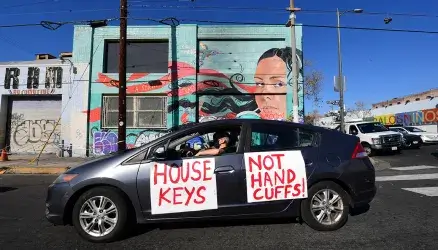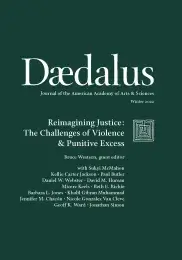
The Story of Violence in America
American history is characterized by its exceptional levels of violence. It was founded by colonial occupation and sustained by an economy of enslaved people who were emancipated by a Civil War with casualties rivaling any conflict of nineteenth-century Western Europe. Collective violence continued against African Americans following Reconstruction, and high levels of lethal violence emerged in American cities in the twentieth-century postwar period. What explains America’s violent exceptionalism? How has structural violence against African Americans become ingrained in American culture and society? How has it been codified by law, or supported politically? Can we rectify and heal from our violent past?
The Problem of State Violence
When violence occurs, the state has an obligation to respond to and reduce the impacts of it; yet often the state originates, or at least contributes to, the violence. This may occur in a variety of ways, including through the use of force by police, pretrial incarceration at local jails, long periods of incarceration in prisons, or abuse and neglect of people who are incarcerated. This essay explores the role of the state in responding to violence and how it should contribute to reducing violence in communities, as well as in its own operations. Finally, it explores what the future of collaboration between state actors and the community looks like and offers examples of successful power-sharing and co-producing of safety between the state and the public.
Public Health Approaches to Reducing Community Gun Violence
Successful public health efforts are data-driven, focused on unhealthy or unsafe environments as well as risky behaviors, and often intentional about reforming systems that are unjust and harm public safety. While laws and their enforcement can be important to advance public health and safety, including reducing gun violence, minimizing harms of exposure to the criminal justice system is also important. Research demonstrates that appropriately targeted efforts that invest in and support individuals and neighborhoods at greatest risk for involvement in gun violence can be successful in saving lives and reaping impressive return on investment.
Seeing Guns to See Urban Violence: Racial Inequality & Neighborhood Context
Guns are central to the comprehension of the racial inequalities in neighborhood violence. This may sound simple when presented so plainly. However, its significance derives from the limited consideration that the neighborhood research paradigm has given guns: they are typically conceived of as a background condition of disadvantaged neighborhoods where violence is concentrated. Instead, I argue that guns belong at the forefront of neighborhood analyses of violence. Employing the logic and language of the ecological approach, I maintain that guns must be considered as mechanisms of neighborhood violence, with the unequal distribution of guns serving as a critical link between neighborhood structural conditions and rates of violence. Furthermore, I make the case that American gun policy should be understood as a set of macrostructural forces that represent a historic and persistent source of disadvantage in poor Black neighborhoods.
Developmental & Ecological Perspective on the Intergenerational Transmission of Trauma & Violence
The focus of this essay is on understanding the development and maintenance of patterns of violent behavior for the purpose of identifying points of prevention and intervention. Close attention is paid to using person-centered language that does not conflate exhibiting violent behaviors with being a violent person. There is a meaningful perceptual difference between discussing the behaviors of a violent person versus discussing a person who engaged in violent behaviors: the former is more likely to be associated with immutable characteristics of a person and the latter is more likely to be associated with attempts at understanding social and contextual causes of the behavior.
The Effects of Violence on Communities: The Violence Matrix as a Tool for Advancing More Just Policies
In this essay, I illustrate how discussions of the effects of violence on communities are enhanced by the use of a critical framework that links various microvariables with macro-institutional processes. Drawing upon my work on the issue of violent victimization toward African American women and how conventional justice policies have failed to bring effective remedy in situations of extreme danger and degradation, I argue that a broader conceptual framework is required to fully understand the profound and persistent impact that violence has on individuals embedded in communities that are experiencing the most adverse social injustices. I use my work as a case in point to illustrate how complex community dynamics, ineffective institutional responses, and broader societal forces of systemic violence intersect to further the impact of individual victimization. In the end, I argue that understanding the impact of all forms of violence would be better served by a more intersectional and critical interdisciplinary framework.
Faces of the Aftermath of Visible & Invisible Violence & Loss: Radical Resiliency of Justice & Healing
As a victim/cosurvivor, my experiences with the criminal justice system have called me to confront hard truths and the brutal facts of coming to terms with death, life, meaning, responsibility, and healing in innumerable ways. The real and tangible balance as a practitioner, victim, and healer are oftentimes disconnected from theory, practice, and life and death experiences. What does it mean to be human in the processes of restoration and reconciliation while hosting complexities, contradictions, and complacencies that all too often reduce victims/cosurvivors to being forgotten, dismissed, and neglected within the criminal justice system? Why do communities of people who long for and deserve trauma-informed interconnectedness, restoration, healing, and reconciliation continue to suffer from the absence of them? My multidimensional perspective as a victim and advocate grapples with my role as a practitioner as it relates to bodies of evidence, theories, best practices, and justice policies.
The Foundational Lawlessness of the Law Itself: Racial Criminalization & the Punitive Roots of Punishment in America
Empirical researchers and criminal justice practitioners have generally set aside history in exchange for behavioral models and methodologies that focus primarily on crime itself as the most measurable and verifiable driver of American punitiveness. There are innumerable legal and political questions that have arisen out of these approaches. Everything from the social construction of illegality to the politicization of punishment to the stigmatization of physical identities and social statuses have long called into question the legal structures that underpin what counts as crime and how punishment is distributed. And yet, until quite recently, the question of what history has to offer has mostly been left to historians, historically minded social scientists, critical race and ethnic studies scholars, community and prison-based activists, investigative journalists, and rights advocates. What is at stake is precisely the foundational lawlessness of the law itself. At all times, a White outlaw culture that rewarded brute force and strength of arms against racialized others unsettles basic assumptions about how we are to understand criminalization and punitiveness over time: that is, who has counted as a criminal and to what end has the state used violence or punishment?
Criminal Law & Migration Control: Recent History & Future Possibilities
Immigration enforcement in the United States has undergone a revolutionary transformation over the past three decades. Once episodic, border-focused, and generally confined to the efforts of a relatively small federal agency, immigration enforcement is now exceedingly well-funded and integrated deeply into the everyday policing of the interior United States. Not only are federal immigration agents more numerous and ubiquitous in the interior, but immigration enforcement has been integrated into the policing practices of state and local officials who once saw their purview as largely distinct from that of federal immigration enforcement agents. This essay briefly explains these developments, from shortly before the passage of the Immigration Reform and Control Act of 1986 through the present day, and assesses their consequences. It includes a brief discussion of the ways states and localities have responded to federal enforcement trends, whether through amplification or constraint.
Due Process & the Theater of Racial Degradation: The Evolving Notion of Pretrial Punishment in the Criminal Courts
Most theorists assume that the criminal courts are neutral arbiters of justice, protected by the Constitution, the rule of law, and court records. This essay challenges those assumptions and examines the courts as a place of punitive excess and the normalization of racial abuse and punishment. The essay explains the historic origins of these trends and examines how the categories of “hardened” and “marginal” defendants began to assume racialized meanings with the emergence of mass incarceration. This transformed the criminal courts into a type of public theater for racial degradation. These public performances or “racial degradation ceremonies” occur within the discretionary practices and cultural norms of mostly White courtroom professionals as they efficiently manage the disposition of cases in the everyday practice of law. I link these historical findings to a recent study of the largest unified criminal court system in the United States–Cook County, Chicago–and discuss court watching programs as an intervention for accountability and oversight of our courts and its legal professionals.
Recognition, Repair & the Reconstruction of “Square One”
The concept of a “square one” in societal organization is a curious thing, and challenging analytic, given the stubborn presence of the past. Even if not meant literally, the Square One Project, like much of the polity, envisions a new starting point, where social policy and practice might turn in a more equitable and inclusive direction. Yet we must grapple with what this restarting point is, in a sociological rather than political sense, and how the present can reasonably be conceived–and actively reconfigured–as an opportunity to start over. I argue that the Square One Project imagines yet another societal reconstruction, in which attending to old and more recent histories of racial violence remains critical to achieving a sustainable vision and practice of equal and legitimate justice. To that end, I encourage a wide-ranging array of efforts under the banner of monumental antiracism to prepare the ground for square one justice.
Knowing What We Want: A Decent Society, A Civilized System of Justice & A Condition of Dignity
Human dignity as a value to guide criminal justice reform emerged strikingly in the 2011 Supreme Court decision in Brown v. Plata. But with Justice Kennedy retired and courts generally reluctant to go far down the road to practical reforms, its future lies in the political realm shaping policy at the local, state, and national levels. For human dignity to be effective politically and in forming policy, we need a vocabulary robust enough to convey a positive vision for the penal state. In this essay, I discuss three concepts that can provide more precision to the potential abstractness of human dignity, two of which the Supreme Court has regularly used in decisions regarding punishment: the idea of a “decent society,” the idea of a “civilized system of justice,” and the idea of a “condition of dignity.” In brief, without a much broader commitment to restoring a decent society, and to civilizing our justice and security systems, there is little hope that our police stations, courts, jails, and prisons will provide a condition of dignity to those unfortunate enough to end up in them.
